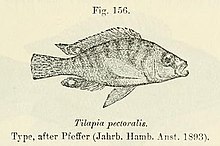Our website is made possible by displaying online advertisements to our visitors.
Please consider supporting us by disabling your ad blocker.
Ctenochromis pectoralis
| Pangani haplo | |
|---|---|

| |
| Scientific classification | |
| Domain: | Eukaryota |
| Kingdom: | Animalia |
| Phylum: | Chordata |
| Class: | Actinopterygii |
| Order: | Cichliformes |
| Family: | Cichlidae |
| Genus: | Ctenochromis |
| Species: | †C. pectoralis
|
| Binomial name | |
| †Ctenochromis pectoralis Pfeffer, 1893
| |
| Synonyms | |
|
Haplochromis pectoralis (Pfeffer, 1893)[2] | |
Ctenochromis pectoralis, the Pangani haplo (short for "haplochromine"), is a species of fish in the family Cichlidae. It was originally characterized in the Pangani River of Tanzania, and may also be present in Kenya. It is listed as extinct by IUCN as a result of a 1996 evaluation,[3] but this appears to be incorrect.[2] A more recent IUCN publication stated that this species is not endangered in any way.[4]
Two isolated populations of similar fish have been reported from springs flanking Mount Kilimanjaro, with some disagreement as to whether they represent the same or distinct related species: at the Kikuletwa Hot Springs of Hai District of Kilimanjaro Region, upstream of the Pangani,[5][6][7] and the Mzima Springs, in the Tsavo River drainage, Kenya.[8] The latter is listed as a distinct, vulnerable species, C. aff. pectoralis, by IUCN.[9]
- ^ Kaufman, L. (1996). "Ctenochromis pectoralis". IUCN Red List of Threatened Species. 1996: e.T9722A13011299. doi:10.2305/IUCN.UK.1996.RLTS.T9722A13011299.en. Retrieved 15 November 2021.
- ^ a b c d Froese, Rainer; Pauly, Daniel (eds.). "Ctenochromis pectoralis". FishBase. April 2013 version.
- ^ Kaufman, L. (1996). "Ctenochromis pectoralis". IUCN Red List of Threatened Species. 1996: e.T9722A13011299. doi:10.2305/IUCN.UK.1996.RLTS.T9722A13011299.en. Retrieved 10 February 2020.
- ^ IUCN Eastern Africa Programme (2003). Pangani Basin: A Situation Analysis. IUCN-EARO Publication Servie. p. 27. ISBN 978-2831707600.
- ^ Job de Graaf, 2011, The Real Ctenochromis pectoralis. Eyespots no. 6, pp. 38-39 [1]
- ^ Van Heusden, H. 2015, Ctenochromis pectoralis: A most mysterious Tanzanian river cichlid. Cichlid News 24:14–17.
- ^ Kalacska, Margaret; Arroyo-Mora, J.; Lucanus, Oliver; Kishe-Machumu, Mary (2017). "Land Cover, Land Use, and Climate Change Impacts on Endemic Cichlid Habitats in Northern Tanzania". Remote Sensing. 9 (6): 623. Bibcode:2017RemS....9..623K. doi:10.3390/rs9060623.
- ^ Okeyo, D.O., 1998, "Updating names, distribution and ecology of riverine fish of Kenya in the Athi-Galana-Sabaki River drainage system", Naga, ICLARM Q. 21(1):44-53 [2]
- ^ Hanssens, M. (2004). "Ctenochromis aff. pectoralis". IUCN Red List of Threatened Species. 2004: e.T60417A12362721. doi:10.2305/IUCN.UK.2004.RLTS.T60417A12362721.en. Retrieved 10 February 2020.
Previous Page Next Page
Ctenochromis pectoralis Catalan Ctenochromis pectoralis CEB Ctenochromis pectoralis German Ctenochromis pectoralis Spanish Ctenochromis pectoralis EU Ctenochromis pectoralis French Ctenochromis pectoralis Italian Ctenochromis pectoralis Dutch Ctenochromis pectoralis Portuguese Ctenochromis pectoralis Serbian



